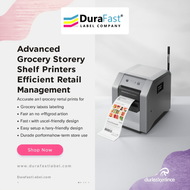How Shelf Tags for Grocery Stores Improve Shopping Experience?
15th Oct 2025
Smart labeling solutions are transforming the grocery shopping experience, making it easier for customers to locate products, compare prices, and make informed choices. Shelf tags for grocery stores play a key role in this process, providing clear, visible information that enhances convenience and boosts customer satisfaction. These small but powerful tools not only guide shoppers efficiently but also help stores maintain organized, well-presented aisles.
From traditional printed tags to modern customizable labels, these solutions connect products with consumers while improving store operations.
Why Shelf Tags Are Essential in Grocery Stores
-
Clear Pricing and Product Information
The main purpose of shelf tags is to communicate pricing information effectively. A well-designed shelf tag allows customers to quickly see the price of a product, reducing confusion and speeding up purchasing decisions.
Many shelf tags provide essential product information, including ingredients, nutritional facts, and allergen warnings. This transparency helps build trust, especially for shoppers with dietary restrictions or specific preferences.
-
Highlighting Promotions and Offers
Promotional shelf tags grab attention and encourage impulse buying. Shoppers are naturally drawn to sales, discounts, and special offers, and well-positioned shelf tags ensure these deals are noticed. Using a retail shelf tag printer, store managers can easily update promotional tags, keeping information accurate and timely.
The Evolution of Shelf Tags in Grocery Retail
-
Traditional Paper Shelf Tags
Grocery stores have used paper tags for years because they are easy to produce and cost-effective. However, updating them frequently can be labor-intensive and prone to mistakes, especially during sales and seasonal changes.
-
Digital and Customizable Options
Modern grocery stores are increasingly using digital or custom shelf tags. These labels, often printed with name tag printers, can include enhanced designs, QR codes, and dynamic pricing options. Digital shelf tags enable instant updates across multiple locations, saving time and improving accuracy.
Benefits of Using Shelf Tags in Grocery Stores
-
Streamlined Shopping Experience
Shelf tags help customers find products more quickly. Clear labeling enables faster decision-making and enhances the overall shopping experience.
-
Enhanced Inventory Management
Accurate shelf tags assist staff in monitoring stock levels and reordering products efficiently. By using grocery store shelf labels, stores can maintain consistency across aisles and minimize out-of-stock issues.
-
Increased Sales and Customer Engagement
Shoppers are more likely to engage with products that are well-labeled and clearly priced. Shelf tags can also highlight premium products or new arrivals, which boosts overall sales.
Best Practices for Implementing Shelf Tags
- Use Clear Fonts and Colors: Make sure prices and product information are easy to read. Choose fonts that can be seen from a distance and choose colors that contrast well with the background. This will help customers quickly identify products without confusion, making their shopping experience smoother.
- Update Regularly: Ensure promotions, discounts, and product information are current. Outdated tags can frustrate customers and create mistrust in your store. By regularly checking and refreshing shelf tags, you maintain accurate information and encourage repeat visits.
- Integrate Technology: Consider digital labels or QR codes for additional information. These tools can provide real-time updates, detailed product descriptions, and links to online recipes. This technology reduces paper waste and simplifies the labeling process.
- Train Staff: Ensure employees know how to use retail shelf tag printers and update tags quickly. Staff should understand how to handle errors, replace labels, and maintain equipment. Proper training ensures a consistent and professional presentation while reducing downtime during busy hours.
- Maintain Consistency: Keep tag sizes, shapes, and designs uniform for a professional appearance. Consistency helps customers easily identify product information and improves store aesthetics. A uniform look strengthens brand identity and creates an organized shopping environment.
Conclusion
Effective labeling should provide more than just prices; it should enhance the shopping experience. Well-designed tags help customers make informed choices, assist staff with inventory management, and improve overall store efficiency.
Modern solutions, including customizable and digital labels, offer added benefits such as real-time updates, a professional look, and increased customer engagement.
For businesses looking to upgrade their labeling systems, DuraFast Label Company provides a wide range of high-quality equipment and expert guidance to help grocery stores implement efficient and eye-catching solutions that elevate the shopping experience.
FAQs
- What are shelf tags in grocery stores?
Shelf tags are labels placed on store shelves that display product prices, promotional offers, and important product information.
- How do retail shelf tag printers help stores?
They enable stores to create accurate, easy-to-read labels quickly and efficiently, saving time and minimizing errors.
- Can I use a name tag printer for product labeling?
Yes, a name tag printer can create custom labels, including product names, promotional details, and QR codes for digital integration.
- How often should grocery store shelf labels be updated?
Labels should be updated whenever pricing, promotions, or product information changes, usually weekly or during seasonal promotions.
- Do digital shelf tags provide advantages over traditional paper tags?
Digital tags can be updated remotely, display dynamic content, reduce labor costs, and improve customer engagement.
- Are shelf tags required by law?
Retailers must follow regulations for pricing and labeling products. Shelf tags help ensure compliance.
- Can shelf tags improve customer satisfaction?
Absolutely, Clear and visually appealing tags help shoppers make quick decisions and enhance their overall shopping experience.
- How do shelf tags contribute to inventory management?
They provide accurate product information, helping staff track stock levels and reorder efficiently.
